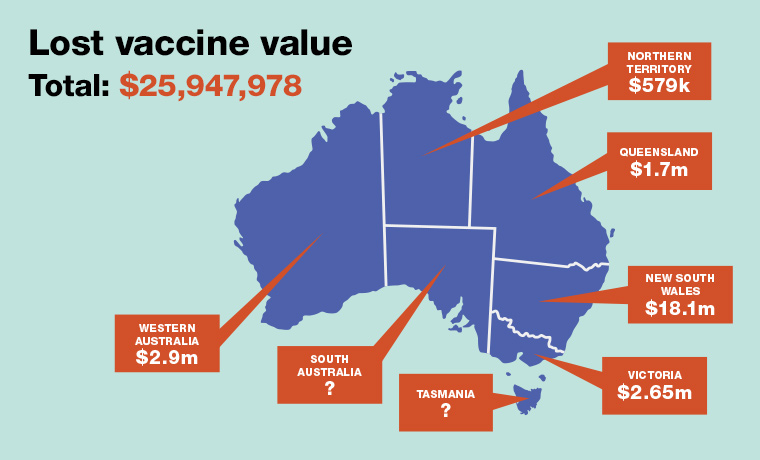Feature
Tip of the cold chain iceberg? Vaccines worth $26 million lost
EXCLUSIVE: At least $25.9 million in Australian vaccines has been lost to cold chain breaches since 2014, but incomplete government statistics mean the final total could be much higher.
 More than 12,000 cold chain breaches were recorded nationwide over the past five years.
More than 12,000 cold chain breaches were recorded nationwide over the past five years.
More than 12,000 cold chain breaches were recorded nationwide over the past five years, resulting in at least 747,000 destroyed vaccines, or 1.65% of the total distributed, newsGP has learned.
Direct comparisons between jurisdictions has proved difficult, as many, such as the Northern Territory and Victoria, were unable to provide statistics dating back five years. Others, such as Tasmania and South Australia, refused to provide meaningful statistics.
However, major variances in comparable data, such as the percentage of vaccines discarded and their individual costs, raise further questions.
Of the states and territories that did provide statistics, New South Wales clearly recorded the highest number of breaches (4024) between 2014 and 2018, as well as destroyed vaccines (approximately 500,000).
Based on the average value lost per breach in 2018, approximately $18.1 million worth of vaccines were wasted in NSW during the five-year period – more than six times higher than Western Australia, the next closest state.
A NSW Health spokesperson told newsGP that a new cold chain procedure enacted at the start of 2019 has helped reduce losses and limited the percentage of distributed vaccines destroyed to 7%.
By contrast, figures supplied by the Victorian Department of Health indicate it has discarded just 0.15% of vaccines distributed between January 2016 and 30 June 2019 – the lowest rate in the country. However, the state also spent around $2.65 million replacing the 93,047 destroyed vaccines at a cost of $115 each, more than three times the estimated national average of $34.70.
In comparison, Queensland said it has spent just $22.90 replacing each of the around 74,000 vaccines it destroyed due to cold chain breaches between 2014 and 2018.

Tasmanian and South Australian health departments did not provide meaningful statistics related to cold chain breaches.
The new NSW cold chain procedure allows some vaccines exposed to temperatures outside of 2–8⁰C to still be used on patients. This assessment is made by public health officials, and is based on thermostability data that NSW Health said it has sourced for most government-funded vaccines.
The NSW Health said the new procedure allows public health units to apply a consistent assessment and response to breaches, and has helped limit losses.
‘As part of the cold chain breach assessment, the public health unit staff apply the manufacturers’ thermostability data to the exposed vaccines, using temperature data from the fridge’s data logger,’ the spokesperson said.
‘The public health unit assessment is comprehensive, including assessment of fridge type, vaccine-ordering history, reason for cold chain breach and staff training.’
However, Research Professor at Flinders University, Professor Nikolai Petrovksy, told newsGP he has some doubts about the new procedure.
‘The concern of cold chain breaches is what they don’t tell you,’ he said. ‘Unless vaccines are being monitored by continuous-monitoring devices, then it is generally impossible to know how long a breach has occurred for and what was the maximum excursion.
‘This makes it hard to know which vaccines to keep and which to throw out.
‘Most vaccines might withstand a temperature excursion upwards of, say, 10⁰ for even weeks or months, but even a very temporary drop in temperature below zero that causes freezing can destroy many vaccines.’
Professor Petrovsky also said it is unclear what algorithm public health units are using to determine whether a vaccine is kept or discarded, or whether it is left to the discretion of the official concerned.
‘What this story highlights is the importance of more research being conducted into these vaccine issues which have largely flown under the radar until now,’ he said.
‘At the moment it is hard to know whether the higher event rates in some states is due to less effective processes for storage of vaccines or is actually due to those states with higher rates actually being more zealous in detecting and recording breaches.’
Following the introduction of the new procedures, the average value of vaccines lost in a cold chain breach has decreased from $4500 in 2018 to $2300 in 2019.
The Tasmanian and South Australian health departments refused to provide meaningful statistics related to cold chain breaches.
Writing in a text message, a spokesperson for the Tasmanian Department of Health and Human Services told newsGP, ‘This information is provided to the Commonwealth and as such is not for the Tasmania’s (sic) Public Health Service to release’.
The spokesperson would not say how or why Tasmania differed from other states and territories that released the requested information, nor why a Federal Government spokesperson directed cold chain breach enquiries to the relevant state and territory departments.
However, newsGP was able to ascertain that Tasmania recorded the highest percentage of vaccine wastage and leakage of any jurisdiction in Australia in 2017–18, with 7.27%. It was also the only state or territory that failed to meet Commonwealth benchmarks related to wastage and leakage during that period.
Likewise, Dr Louise Flood, SA Health’s Director of the Communicable Disease and Control Branch, did not answer questions and would only confirm in a written statement that, since 2014, ‘the proportion of vaccines discarded in SA due to cold chain breeches (sic) is 0.34%’. This figure did not include wastage due to state-wide power outages.
newsGP has lodged Freedom of Information requests in both states to obtain the requested statistics.
cold chain immunisations vaccines
newsGP weekly poll
As a GP, do you use any resources or visit a healthcare professional to support your own mental health and wellbeing?